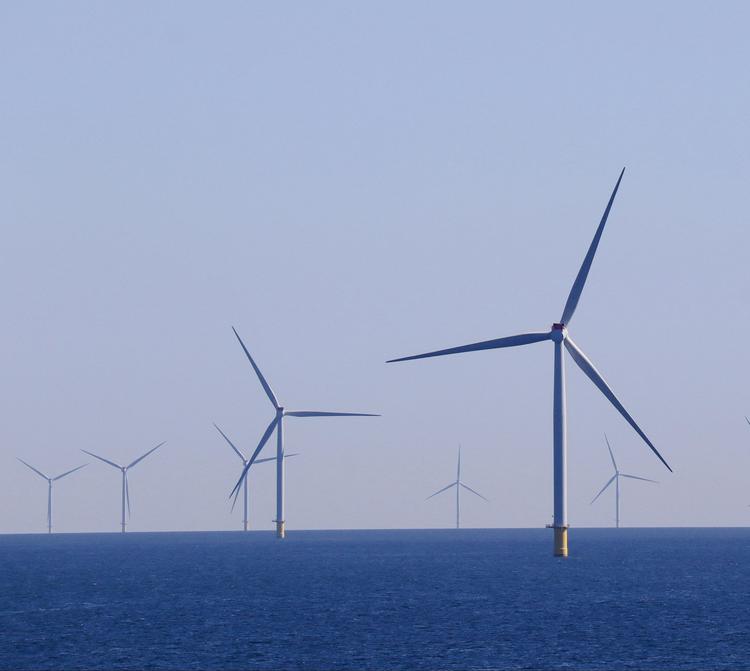Ann Arbor (Informed Comment) – Trump has halted the Bureau of Ocean Energy Management from granting new offshore wind licenses. This move will gut the growing US offshore wind industry, though it does not necessarily affect already-granted licenses.
Gavin Maguire at Reuters explains the outcome of this policy will be high energy costs for Americans, who will be thrown back on expensive fossil gas. In North America, gas costs 6.5 cents per kilowatt hour. Onshore wind is 4.2 cents per kilowatt hour, and offshore wind comes in at 4.82 cents per kilowatt hour. It doesn’t take a rocket scientist to see that wind power is much cheaper and therefore preferable even apart from climate change issues.
It is bad enough that Trump is effectively raising the electricity rates paid by average Americans. It is even worse that he will be overheating the earth by burning fossil fuels instead of using clean, free wind. But Maguire points out that there is yet another downside. Factories use electricity to manufacture things that are sold abroad. Made goods produced with expensive electricity are more expensive. So Asian countries using solar, wind, offshore wind and batteries will make their exports more cheaply than the United States. In the real world, where you can’t just bloviate your economy to success, cheap competition is bad for America.
Maguire notes that Asia has 2.5 terawatts of clean energy, compared to 1 terawatt in Europe and 0.7 terawatts in North America. That is, Asia has over half of the world’s renewable generation capacity, and 2/3s of that is in China alone. What is even more striking is Asia’s rapid expansion of the sector. Asia put in 450 gigawatts of new renewables capacity last year, leaving Europe (109 gigawatts) and North America (93 gigawatts) far behind.
Wood McKenzie reports that the Asia-Pacific Economic Cooperation nations may tender an unprecedented 10 gigawatts of new offshore wind in 2025, including in established markets like Taiwan, Japan and South Korea, along with new players India and the Philippines. There are some contingencies in the total, but the industry will forge ahead there, unlike in Trump’s backward, dirty America.
South Korea is the seventh-largest trading partner with the US, and has run a consistent trade surplus with us over the past decade. It has so far lagged in renewables, but offshore wind could be a game changer over the next decade. The cheaper its electricity, the cheaper its automobiles, TVs and refrigerators are and the higher will be the US trade deficit, given our dirty, expensive electricity courtesy Trump.
Worse for the US, South Korea’s Hanwha Ocean is innovating in offshore wind turbine design and such lean, hungry companies could come to dominate a growing industry while lack of American experience blunts such advances here.
None of the top ten makers of offshore wind turbines is an American company. And since we won’t have that industry for the rest of this decade, none are likely to emerge.
The trade deficit with Taiwan has been growing in recent years and reached $73 billion in 2024. At the moment, Taiwan’s grid is relatively dirty, depending in part on expensive liquefied natural gas, but its rapid build-out of renewables means that they generated 17% of its electricity last year, and that percentage will ramp up over the next decade, while the US remains mired in expensive fossil fuels. Taiwan aims at having 5.7 gigawatts of offshore wind by the end of 2025. Taiwan is the biggest market for offshore wind in the world aside from mainland China.
Photo by Damir K: https://www.pexels.com/photo/wind-turbines-on-the-sea-13223602/
The US actually had a leg up on both South Korea and Taiwan regarding renewables until Trump got back in and started derailing the industry, but now we will likely fall ever farther behind.
As for India and the Philippines, the US actually has traditionally run a trade surplus with them. But India has made a substantial push on renewables, which generated 46.3% of its electricity last year, with solar and wind leading the way. It has big plans to increase its renewables in the coming years. As its electricity falls in price, India’s manufactures will be ever more competitive, and America’s trade surplus may dwindle.
Of course, Asia’s renewables dominance is led by China, which installed 357 gigawatts of clean energy last year, and which dominates the global solar panel market, with an 80% share. With ever cleaner energy, China will be even more competitive. It is already running a $294 billion trade surplus with the US (which is an American trade deficit).
Although Trump likes to talk a big game about using tariffs to reduce our trade deficits, he failed to do so with regard to China in his first term, as I pointed out: “As for China, the US trade deficit with that country in the last year of the Obama administration was $373 billion adjusted for inflation since. In the first two years of Trump it skyrocketed to $432 billion. Trump then panicked and slapped high tariffs on Chinese goods, and wrestled the China deficit in 2019 back down to $350 billion. All his effort just got us just about back to where Obama had been.”
By locking America into expensive dirty energy, Trump is guaranteeing future balance of trade deficits and further erosion of American manufacturing.



 © 2025 All Rights Reserved
© 2025 All Rights Reserved